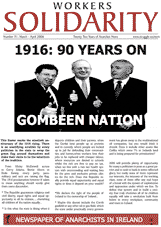Over 30 years of anarchist writing from Ireland listed under hundreds of topics
Cartoons and Caricatures
By now we are all familiar with the cartoons commissioned and published by the Danish magazine Jllands – Posten which aroused such anger in the Muslim world and in Muslim communities worldwide.
Published at a time when Denmark is in the process of a debate over immigration the reaction to the cartoons seemed to exemplify the so called ‘clash of Civilisations’ between Islam and the West. In the red corner: a European magazine standing in the tradition of the Enlightenment and defending the right to free speech. And in the blue corner: backward superstitious Muslims, the beheaders of hostages and the oppressors of women. As the debate spread things seemed to become even more polarised. Dick Cheney took the opportunity to remind us of the dangers of Islamo-fascism, European consulates and embassies were attacked in the Middle East and radical Islamists took to the streets of London calling for non believers to be executed.
However just as the cartoons simplified and obscured the reality of Muslim attitudes, the media coverage caricatured and simplified the debate. The real world was much less black and white then the media portrayal. Jllands-Posten was eventually revealed not to be a brave defier of censorship but a source of anti immigrant rhetoric, whose owner had campaigned for Muslims to be expelled from Denmark and who had, in 2003, refused to publish cartoons depicting Christ on the grounds that they were offensive! The ‘defenders of free speech’ in Ireland – people like Kevin Myers and a collection of hacks from the Sunday Independent turned out to have no sense of either irony, history or their own hypocrisy. These same people were often the loudest and most strident supporters of the anti republican Section 31 censorship when it was in force in Ireland. They are also the most vocal cheerleaders of the various wars in Afghanistan, Iraq and potentially Iran… curious eh?
On the other side it emerged that hardline Danish imams had toured the cartoons around the Muslim world for months, and even added their own! They were welcomed by the religious right and Muslim governments. Undemocratic states in the Middle East used and encouraged the protests in an attempt to legitimise their dictatorial power. Questions began to be asked about how demonstrators managed to set fire to embassies in countries like Syria where anti government protestors are regularly arrested, tortured and ‘disappeared’. In a move which reminded us of ‘freedom fries’ the Iranian president declared that ‘Danish pastries’ were to be renamed ‘flowers of Mohammad’. Possibly he hoped that this shallow populist gesture would distract from the fact that his government was at that time engaged in a ferocious crackdown on striking bus drivers in Teheran. Setting up an illegal independent trade union and defying the paramilitary police oppression the struggle by the bus workers of Teheran shows that the Muslim world is not some homogenous block but that it does in fact contain a diversity of views.
Not all the protests were orchestrated or whipped up by the religious right or state tyrants. The cartoons were racist and offensive – they stereotyped Muslims (and especially Arabs) as suicide bombers and lunatics. In the context of the ‘war on terror’ and the debates in Europe over Islam and immigration it’s not surprising that a community under attack took offence to something which would have been better ignored.
However we should also be clear that religious ideas, like any others, are fair game for critique, criticism and attack. In Ireland we have fought and are still fighting against the religious right for basic freedoms such as divorce, birth control, the acceptance of homosexuality and the provision of abortion. These are things we demand, and it doesn’t matter whether or not they conflict with anyone’s religious beliefs.
From Workers Solidarity 91, March/April 2006
PDF file online at http://www.wsm.ie/sites/default/files/ws91.pdf


